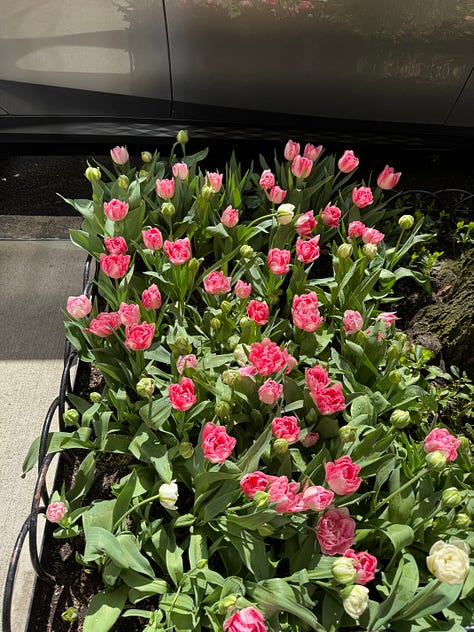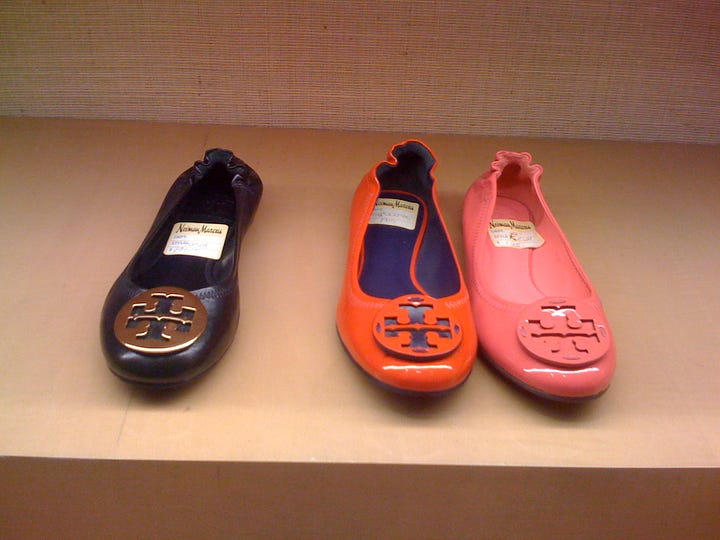Before we dive into the topic du jour, let’s take a moment to appreciate THE WEATHER. As someone who didn’t grow up with seasons (other than scalding and temperate), I used to find the sheer excitement around changes in the weather quite annoying. Now, as I approach my seventh year on this island (can you believe? Can I believe?) I, too, have succumbed to the joys of Mother Nature, as I now understand what all the hubbub has been about. It’s so hard for anything to survive in New York City - people, nature, anything with a pulse. If you spoke to me in January vs in April, you’d be speaking to two completely different people. The flowers blooming and the sun shining signify we all made it to the other side, together. My camera roll is filled with rewards for survival; purple and pink and green and yellow. I’ve been giving out compliments to random strangers on their outfits. I enjoy watching people run, bike, and take in the sunset. It feels like everyone is smiling more. I feel like the Grinch at the end of the story when he ends up with a heart. I haven’t even made one comment on the fact that every girl is starting to adopt the warm weather uniform of sneakers and a midi skirt, and a baby tee! Is this what being a Good Samaritan feels like? (Don’t worry, I’m still saying no to every lemonade stand I walk by. You’re a cute kid, but you’re standing outside of a building in Tribeca that I know, for a fact, doesn’t have an apartment for less than three million in it. Nice effort, though.)



Now, let's move on to why we’re all here - organic dairy milk and Tory Burch flats.
I received two emails over the past two months that provided the impetus for today’s newsletter. The first email was from Alfred Coffee. For those of you that did not travel to / live in L.A. between the years of 2013-2019, Alfred Coffee is an expensive and decent-ish coffee shop that took off due to their Instagram-able (back in the days when it was legitimately cool to post a picture of your drink with the contrast turned all of the way up) branding of a mustache on all of their products. For those of you wondering why I did not include it in my Big Coffee commentary piece, it’s because it’s no longer cool. It’s still decent, still expensive, but the Community Goods and Marus of the world have pushed Alfred and its mustache into a sepia-toned shadow. For some reason, I’m signed up for their marketing emails, which I am almost ninety-nine percent positive I have marked for spam for a decade, yet continue to appear in my inbox.
When I received the below email in March, I briefly clicked to open it and laughed. Alfred’s was one of the first trendsetters to serve and push almost every variation of non-dairy milk, which is what made this email all the more fun. I’m almost positive the first time I tried almond milk was at Alfred's (and you always remember your first non-dairy experience, don’t you.) Once opened, I left the email alone in the purgatory section of my inbox, where emails that I don’t need to immediately respond to and/or want to delete eventually, but need them for a specific thought that I haven’t fully formed yet, live.
Then, a month later in April, I received a marketing email from Ssense on the launch (or re-launch, rather) of Tory Burch’s Reva flat. Again, for those who don’t know (I’m really assuming a lot about my readership today), Ssense is a Canadian luxury multi-brand retailer that specializes in designer fashion and high-end streetwear. Now, marketing emails from Ssense have been allowed to live in my Inbox due to a lack of self-control in the name of fashion.
I was already intrigued by this email, as Emily Sundberg had broken the news of the Reva flat coming back several days before the Ssense marketing email. If you don’t follow Emily or read her Substack Feed Me, I would highly recommend you change both of those things. One of the coolest people and most talented writers who is building her newsletter into a brand empire.
I digress, and you’re probably confused. You may be asking yourself, Sydney, what does organic dairy milk being served at a has-been coffee shop and the resurgence of a pair of shoes I wore in the seventh grade have anything to do with one another? Great question, my thoughtful readers! I’ll tell you. What both of these things have in common is that they are not new. Not a new concept, or idea, or product, or application of a product, or UX experience, or any other way you can define new. Yet, they are being pushed out, and hoping to be perceived as such, when they are, in fact, unoriginal and circular.
Dairy, as we all know and are exhausted from, has gone from enemy number one to highly revered. We are somewhere amidst the zenith of the wellness revolution(s) that involve a ballerina from Julliard moving to Utah and drowning in the money she’s making off of her videos around drinking raw milk and cooking three types of pies with two children on each hip in an oven from the 1900s, and the general public realizing that dairy was actually never bad for you in the first place, and was only made bad by America’s pasteurization process and treatment of cows, and A2 milk from organic farmers and free range cows that may be better for you than almond milk that has fifteen types of xanthan gum to stabilize it and create a flavor profile very similar to milk anyway. I’m out of breath. Anyone else? The false premise of the email is what made me laugh, as well as the “We dair(y) you to make the switch.” I just know some intern or low-level social media marketing exec was tasked with coming up with the copy for this email, typing into Chat GPT variations of “clever phrases with dairy in them” over and over again. Dairy really never left, but most hyper-local niche markets forget that a majority of America does not follow in their footsteps.
The Tory Burch flat presents a similar level of circularity. The marketing for the Reva details “a modern design that’s found a new home with downtown It girls.” What makes it modern, the fact that you can see toe cleavage now through the emblem? To me, as a once faithful owner of multiple pairs of those flats that I religiously wore to every “dress up” event in my life from ages thirteen to seventeen, I look at those shoes and instantly hear someone yelling at me to get ready faster or remember the blisters they always caused on my pinky toes. They were always a little too stiff, a little too shiny, and a little too eager to be taken seriously. (Like the middle school girls wearing them, including myself.) The only thing that has really changed is the styling and marketing - Revas with wide-leg denim and a $1,200 Loewe tank top, instead of paired with a Betsey Johnson dress and a dream (see below). Tory Burch jumped onto the “office siren” trend, as coined by Emily (see above), at the tail end of its relevance. Now, circularity within fashion is not a novel concept. At dinner last night, a friend asked me what I thought of the resurgence of the boat shoe as the hot new ticket for summer. Again, I was brought back to being thirteen and owning at least four pairs of Sperrys (which is hilarious, because what nautical life was I living in Phoenix, Arizona?) Most fashion trends and designers, especially of couture houses, are respected for pulling “inspiration” from past years and seasons. And most of the creative directors of these couture houses spend their careers being pulled from brand to brand, (Veronica Leoni moving from The Row to Calvin Klein, Matthieu Blazy from Bottega Veneta to Chanel, Sarah Burton from Alexander McQueen to Givenchy, to name a few), regurgitating what they have done at other houses and what their predecessors have done. Everything is out of vogue until it’s once again in vogue and then out, and so forth.


What Alfred Coffee’s dairy campaign and the Tory Burch Reva resurrection share is the same cultural core: nothing is actually new. Originality has become a myth of bygone times. A marketing trick. A fever dream conjured by VC-backed kombucha brands and people who think “creative director” is a personality. We are not inventing, we are remixing. Recurating. Re-contextualizing. Sometimes with intention, often out of laziness, and occasionally because there’s nothing left to mine. I went on a walk with a friend this week who has their own business, and they detailed that most of their business’s social plays and marketing campaigns are variations of other relevant and successful social plays and marketing campaigns from popular companies. This is not a groundbreaking admission, as we’ve all been copying one another since the beginning of time (for survival, and for otherwise), and it’s especially not novel now as we all start to incorporate the same algorithms and AIs into our lives, cannibalizing ourselves and others.
Does the death of originality make a positive argument for circularity? Circularity, for all its eye-roll-inducing ubiquity, is maybe the most honest mode we’ve got. It admits the truth: we keep coming back to the same things because the originals evoke a feeling of safety, of nostalgia, of positivity, and, most importantly, of guaranteed success that feels harder than ever to create from scratch. Sometimes, success comes in the form of a familiar shape of an old idea that once made us feel okay and appealed to the masses. The Reva and dairy are just the latest examples of our collective amnesia masquerading as rediscovery. (I’d love if the Blackberry made its way back to the cultural forefront. Mostly for BrickBreaker.)
What if originality is no longer the goal? What if the goal is resonance? I don’t need my coffee shop to blow my mind, I just need it to taste like 2017 and give me a small serotonin bump when I see a guy in a beanie writing a screenplay he’ll never finish. I don’t need new shoes, I need the idea of a new shoe that makes me believe I have somewhere important to walk to, even if it’s just to spend $9 on the latte that tastes like 2017. There is a quiet beauty in this kind of repetition. Like listening to the same sad song every year on your birthday, just to see if it still hits. (It does.)
We may not ever reinvent the wheel again. There’s a good chance we’ll probably escalate in this cycle as our memories and attention spans get shorter and shorter, and our emotional tolerance gets smaller and smaller. (I see my cynicism has made a reappearance. The spring flowers could only keep it away for so long.) We’re serving up whole milk in serif-font cartons and calling it disruptive. We’re slipping back into the same pair of shoes we once blistered in, convinced this time will be different because the girl in the ad has better lighting. Circularity isn’t failure if you define it as the cultural equivalent of muscle memory. And maybe that’s not such a bad thing. Maybe we’re allowed to want what’s already worked.
Either way, I’ll be on the lookout for comfort-core emails this summer. I’m giving it two months before someone pitches me on a limited-edition UGG revival for fall.








I love your writing. Revival isn’t a bad idea. It’s an idea. Betsy Johnson was great! Super talented
The Roman Empire can be seen everywhere. That will renew your faith!